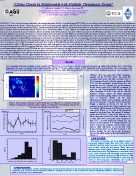Por favor, use este identificador para citar o enlazar este ítem:
https://repositorio.uca.edu.ar/handle/123456789/5430| Campo DC | Valor | Lengua/Idioma |
|---|---|---|
| dc.contributor.author | Lakkis, Susan Gabriela | es |
| dc.contributor.author | Lavorato, Mario | es |
| dc.contributor.other | PEPACG – UCA/CONICET (Programa para el Estudio de Procesos Atmosféricos en el Cambio Global) | es |
| dc.date.accessioned | 2019-06-06T00:48:14Z | - |
| dc.date.available | 2019-06-06T00:48:14Z | - |
| dc.date.issued | 2010 | - |
| dc.identifier.citation | Lakkis, S. G. y M. Lavorato. 2010. Cirrus clouds in relationship with multiple tropopause events [en línea]. Documento de investigación. Universidad Católica Argentina. Facultad de Ciencias Agrarias. PEPACG - UCA/CONICET . Disponible en: https://repositorio.uca.edu.ar/handle/123456789/5430 | es |
| dc.identifier.uri | https://repositorio.uca.edu.ar/handle/123456789/5430 | - |
| dc.description.abstract | Abstract: Cirrus clouds have been identified by the Intergovernmental Panel on Climate Change (IPCC) (2001) as one of the priority areas for research due to their radiative and dynamic influence on the Earth’s climate. Since cirrus clouds are located at high altitudes, their formation mechanism and evolution are sensitive to atmospheric conditions in the upper troposphere and lower stratosphere (UTLS). Therefore, studying UTLS conditions could give important hints on what drives cirrus cloud formation and how to better predict their properties. The tropopause temperature inversion has a constraining effect on cloud altitude, and several studies have focused on the properties of cirrus clouds near the tropopause, but especially at tropical latitudes. Hence variability in the thermodynamic structure of the tropopause could affect the properties of cirrus clouds near the UTLS transition. Multiple tropopauses are symptoms of actual physical phenomena that can help detect and analyze specific atmospheric conditions of cloud formation. This study focuses on the relationship between the tropopause(s) and cirrus clouds, thus only clouds whose top altitudes are located higher than 7 km will be considered. The aim of the work is to study the possible relationship between MT at midlatitudes and ice clouds considering collocated in situ and remote-sensing observations made between 2002 and 2003. Tropopause levels were retrieved from temperature profiles obtained through a data set of radiosoundings (launched at 00 and/or 12 UT) from the Argentine Servicio Meteorológico Nacional (SMN). Lidar observations are provided by the elastic backscatter lidar located in Villa Martelli near Buenos Aires and is based on Nd: YAG laser transmitter which delivers around 300 mJ by pulse at 532 nm with a 10 Hz pulse rate, 5 ns pulse duration, with a tilt angle less than 0.6 mrad. The lapse-rate tropopause definition is based on the variability in lapse rate in an atmospheric temperature profile. This technical definition, which is used in the rest of the present study actually reflects dynamical disturbances to the temperature profile resulting in multiple temperature inversions in the UTLS that can lead to tropopause foldings and mixing of stratospheric and tropospheric air. Analysis of temperature profiles from the Buenos Aires radiosoundings (34.6ºS, 58.5ºW) shows that multiple tropopauses occur in almost 50% of cases, with a third tropopause near 6 % of cases (additional tropopauses were considered to be negligible). Cloud with tops above the first tropopause occur in more than 30% of the observations, out of which a strong 50% happen in a multitropopause situation. These related clouds occupy a limited region between the first and second tropopauses, with their top in the lower of the intertropopause zone. Almost no cirrus cloud was detected with a top altitude above the second tropopause. Therefore it appears that clouds that cross the lowest tropopause live in an unstable temperature profile, which leads a large fraction of them to rise or expand vertically until they reach the next tropopause. | es |
| dc.format | application/pdf | es |
| dc.language.iso | eng | es |
| dc.publisher | Universidad Católica Argentina | es |
| dc.rights | Acceso Abierto | es |
| dc.rights.uri | https://creativecommons.org/licenses/by-nc-sa/4.0/ | es |
| dc.subject | NUBES CIRRUS | es |
| dc.subject | TROPOPAUSA | es |
| dc.title | Cirrus clouds in relationship with multiple tropopause events | es |
| dc.type | Artículo | es |
| uca.path | Facultad de Ingeniería y Ciencias Agrarias|Artículos | es |
| uca.disciplina | INGENIERIA AMBIENTAL | es |
| uca.filename | /home/data-uca-generic/folder_generic_common/Ing. y Cs.Agrarias/Art�culos/cirrus-clouds-relationship-multiple-tropopause/metadata.xml | es |
| uca.issnrd | 1 | es |
| uca.affiliation | Fil: Lakkis, Susan Gabriela. Pontificia Universidad Católica Argentina. Facultad de Ciencias Agrarias. Equipo Interdisciplinario para el Estudio de Procesos Atmosféricos en el Cambio Global; Argentina | es |
| uca.affiliation | Fil: Lakkis, Susan Gabriela. Pontificia Universidad Católica Argentina. Facultad de Ciencias Agrarias; Argentina | es |
| uca.affiliation | Fil: Lavorato, Mario. Instituto de Investigaciones Científicas y Técnicas para la Defensa. Departamento de Investigaciones en Láseres y sus aplicaciones. División Radar Laser; Argentina | es |
| uca.version | publishedVersion | es |
| item.languageiso639-1 | en | - |
| item.grantfulltext | open | - |
| item.fulltext | With Fulltext | - |
| crisitem.author.dept | Pontificia Universidad Católica Argentina | - |
| crisitem.author.dept | Facultad de Ingeniería y Ciencias Agrarias | - |
| crisitem.author.orcid | 0000-0001-7562-8204 | - |
| crisitem.author.parentorg | Pontificia Universidad Católica Argentina | - |
| Aparece en las colecciones: | Artículos | |
Ficheros en este ítem:
| Fichero | Descripción | Tamaño | Formato | |
|---|---|---|---|---|
| cirrus-clouds-relationship-multiple-tropopause.pdf | 316,28 kB | Adobe PDF |  Visualizar/Abrir |
Visualizaciones de página(s)
99
comprobado en 30-abr-2024
Descarga(s)
36
comprobado en 30-abr-2024
Google ScholarTM
Ver en Google Scholar
Este ítem está sujeto a una Licencia Creative Commons

